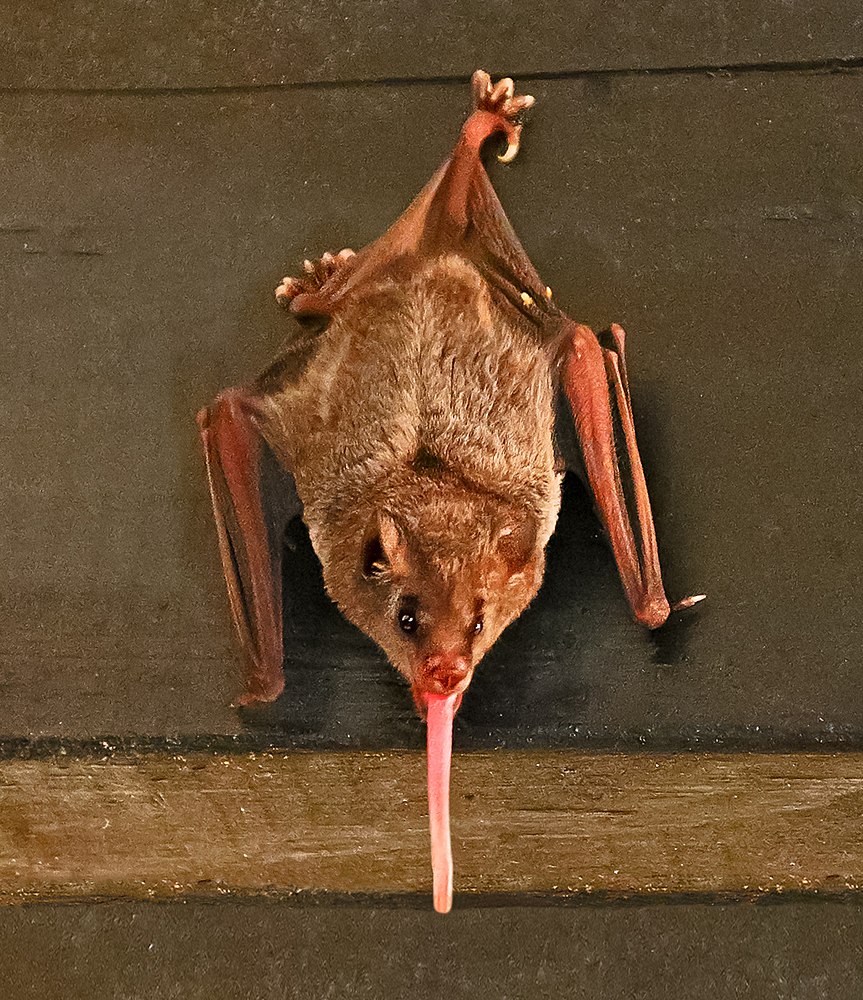It is hard to guess what a Pallas’s long-tongued bat weights. But we have the answer:
An adult Pallas’s long-tongued bat (Glossophaga soricina) on average weights 9 grams (0.02 lbs).
The Pallas’s long-tongued bat is from the family Phyllostomidae (genus: Glossophaga). They can live for up to 10 years. When reaching adult age, they grow up to 4.8 cm (0′ 2″). On average, Pallas’s long-tongued bats can have babies 2 times per year with a litter size of 1.
As a reference: An average human weights in at 62 kg (137 lbs) and reaches an average size of 1.65m (5′ 5″). Humans spend 280 days (40 weeks) in the womb of their mother and reach around 75 years of age.

Pallas’s long-tongued bat (Glossophaga soricina) is a South and Central American bat with a fast metabolism that feeds on nectar.
Animals of the same family as a Pallas’s long-tongued bat
We found other animals of the Phyllostomidae family:
- Godman’s long-tailed bat with a weight of 7 grams
- Insular single leaf bat with a weight of 15 grams
- Thomas’s fruit-eating bat with a weight of 11 grams
- Striped hairy-nosed bat with a weight of 13 grams
- Tailed tailless bat with a weight of 10 grams
- Tilda’s yellow-shouldered bat with a weight of 24 grams
- Buffy flower bat with a weight of 16 grams
- Orange nectar bat with a weight of 13 grams
- Guianan spear-nosed bat with a weight of 134 grams
- Long-legged bat with a weight of 8 grams
Animals with the same weight as a Pallas’s long-tongued bat
As a comparison, here are some other animals that weight as much as the Glossophaga soricina:
- Common shrew bringing 9 grams to the scale
- Thick-eared bat bringing 8 grams to the scale
- Thomas’s horseshoe bat bringing 8 grams to the scale
- Paucident planigale bringing 9 grams to the scale
- Kelaart’s pipistrelle bringing 8 grams to the scale
- Baird’s shrew bringing 8 grams to the scale
- Ozimops planiceps bringing 9 grams to the scale
- Micronycteris nicefori bringing 8 grams to the scale
- American shrew mole bringing 9 grams to the scale
- Bicolored shrew bringing 10 grams to the scale
Animals with the same size as a Pallas’s long-tongued bat
Not that size really matters, but it makes things comparable. So here are a couple of animals that are as big as Pallas’s long-tongued bat:
- Rüppell’s pipistrelle with a size of 4.5 cm (0′ 2″)
- Johnston’s forest shrew with a size of 5.3 cm (0′ 3″)
- Inyo shrew with a size of 5.2 cm (0′ 3″)
- Proboscis bat with a size of 4.2 cm (0′ 2″)
- Southern little yellow-eared bat with a size of 5.3 cm (0′ 3″)
- Thomas’s sac-winged bat with a size of 4 cm (0′ 2″)
- Daubenton’s bat with a size of 4.4 cm (0′ 2″)
- Pygmy shrew tenrec with a size of 5.6 cm (0′ 3″)
- Trident bat with a size of 5.6 cm (0′ 3″)
- Wagner’s mustached bat with a size of 4.5 cm (0′ 2″)
Animals with the same litter size as a Pallas’s long-tongued bat
Here is a list of animals that have the same number of babies per litter (1) as a Pallas’s long-tongued bat:
- Mongolian gazelle
- Gilbert’s potoroo
- Hispid pocket gopher
- Soemmerring’s gazelle
- Thomas’s fruit-eating bat
- Ihering’s Atlantic spiny rat
- Maroon leaf monkey
- Bahamian hutia
- Crested mona monkey
- Brown-mantled tamarin
Animals with the same life expectancy as a Pallas’s long-tongued bat
Completely different animals, but becoming as old as a Pallas’s long-tongued bat:
- Oncilla with an average maximal age of 10 years
- White-lined broad-nosed bat with an average maximal age of 10.17 years
- Philippine porcupine with an average maximal age of 9.5 years
- Mindanao treeshrew with an average maximal age of 11.5 years
- Ground cuscus with an average maximal age of 12 years
- Fischer’s pygmy fruit bat with an average maximal age of 10 years
- Eastern spotted skunk with an average maximal age of 10 years
- African wild dog with an average maximal age of 11 years
- Greater fairy armadillo with an average maximal age of 12 years
- Common dwarf mongoose with an average maximal age of 10.92 years
